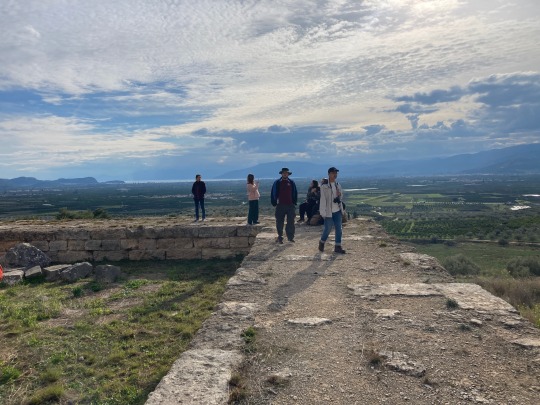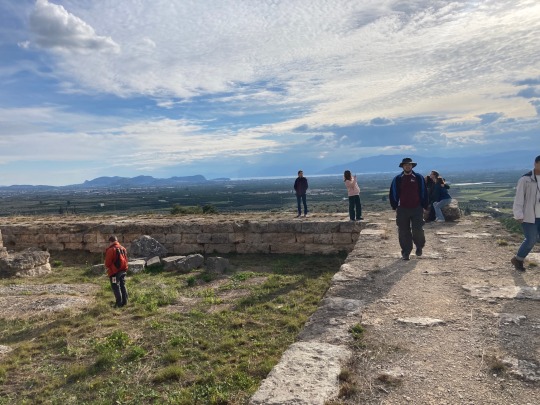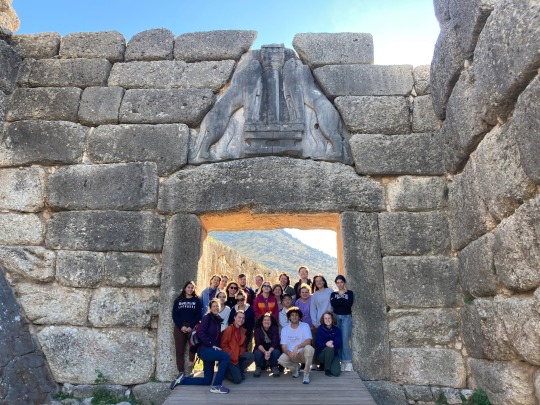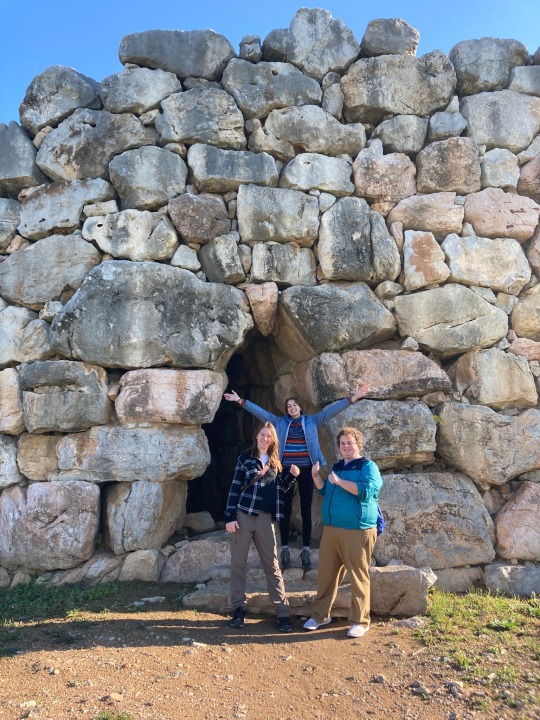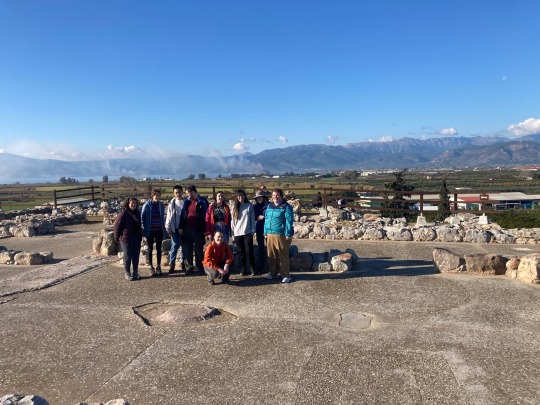#argive heraion
Text
"During the fifth century, when Polykleitus made Hera's cult-statue for her Argive sanctuary, it seems that the cuckoo was considered to be the bird-attribute of this goddess. But six centuries later, Hadrian thought it appropriate to dedicate a gold peacock in the same shrine; for by this time the peacock had become Hera's most prominent associate among the birds. Athenaeus records that peacocks were sacred to Hera, and that they were kept in her sanctuary of Samos; and although he was writing himself only in 200 AD, he was quoting Antiphanes and Menodotus who probably lived in the fourth and third centuries BC, respectively. At all events, during the second century BC, Samian coins began to be minted on which both Hera and her peacock are represented. Both Ovid and the commentator on Euripides explained the appearance of the peacock's tail-feathers by relating the story that when Argus was killed, Hera removed his hundred eyes and placed them in the tail of her bird. This legend shows how the Samian bird had been absorbed into the mythology of Argos, Hera's other principal domain; and explains why Hadrian dedicated his jewelled peacock; but it happened late in the history of the sanctuary. …
In fact, the peacock is rarely represented in Greek art, and the first certainly dated instances of Hera with this bird are Samian coins of the second century BC. It may be argued, however, that the association was established much earlier, during the Archaic period; on the evidence of the scene portrayed on an ivory comb made in about 700 BC. This object happens to have been dedicated to Artemis Orthia in Sparta; … The scene is the Judgment of Paris, and shows the three rival goddesses each with a typical attribute. Aphrodite holds a dove, Athena wears a helmet, and the third goddess, Hera,is accompanied by a bird "which must be supposed to be the peacock" But there is in fact little reason, apart from its long neck, to identify this bird as a peacock. The supposition appears to be based on external evidence of a later date; and I believe it possible that the artist is simply depicting a water-bird, an appropriate enough attribute for Hera, as for many an unspecified Archaic potnia theron. … …
According to the literary evidence cited above, the peacock cannot certainly be associated with Hera any earlier than the fourth century, and then only in Samos. I believe it possible that the Samians may have regarded the peacocks of the Heraion simply as material property of the sanctuary, and not at first, as sacred birds in a religious sense. The aetion for Hera's patronage of the peacock was probably (as the literary evidence suggests) of late invention. The only peacock-representations to be identified with certainty at any of the sanctuaries examined here are the terracotta and marble fragments from the Argive Heraion, which have not been dated, but may well have belonged (like Hadrian's jewelled bird) to the Roman period. In this period, the painted terracotta peacock's tail may have been part of an akroterion or antefix decorating the temple. Waldstein rejected his own original definition of the Geometric bronze bird from this sanctuary as a peacock, and although the bird on an Archaic engraved stone from Perachora could be a peacock (with crest and fan-shaped tail), it is rather small to identify with certainty.
I have suggested that Hera, as one of the Olympian successors to an older potnia theron, may originally have had the attribute of an unspecified water-bird; and that this bird (as I believe it appears on the comb from Artemis Orthia) became a peacock only after the Samian peacocks acquired their reputation. In view of the fact that while peacocks are known to have been dedicated at the Argive Heraion, no remains of their images have come to light at the Samian sanctuary; and since it is King Arguswho figures in the aetion for the peacock's tail, it is even possible that Hera's special association with the peacock, though inspired by the Samian birds, was an Argive invention. The scarcity of peacock-representations in her sanctuaries is therefore not really inconsistent with literary evidence as it has survived. On the other hand, nearly 200 representations of birds of various other kinds (including water-birds) have been reported in the Heraia considered in this study."
- Representations of Animals in Sanctuaries of Artemis and of Other Olympian Deities by Elinor Bevan
#hera#birds#peacocks#samos#samian heraion#argive heraion#argos#attributes#sacred animals#excerpts#quotes#exactly what I've been saying!
8 notes
·
View notes
Text
In the pronaos of the temple are some ancient statues of the Charites, on the right the couch of Hera, and the dedication of a shield that Menelaos once took from Euphorbos at Troy. The great statue of Hera is seated on a throne of gold and ivory, the work of Polykleitos.Its crown has the Charites and Horai worked into it; in one hand she holds a scepter, in the other a pomegranate. As the story of the pomegranate is not to be spoken , I shall omit it. But they say a cuckoo sits on her sceptre because, when Zeus first loved the blossoming Hera, he changed into this bird and she hunted him for a pet.... They say that there stood beside Hera's statue one of Hebe, this too chryselephantine, a work of Naukydes. But on a column beside the (Polykleitean] statue is an ancient statue of Hera. This oldest of statues, made of pear wood and dedicated at Tiryns by Peiras son of Argos, was brought to the Heraion when the Argives captured Tiryns. I myself saw it there, a small seated figure. Interesting dedications include an altar into which the legendary marriage of Hebe and Heracles is worked and the emperor Hadrian's dedication of a peacock of gold and precious stones.
(Pausanias 2.17.46 Rocha-Pereira 1981).
- The Transformation of Hera: A Study of Ritual, Hero, and the Goddess in the lliad
Joan V. O'Brien
#hera#greek mythology#hera goddess#hera greek mythology#research#goddess hera#transformation of hera
12 notes
·
View notes
Text

Hera Apia: Pears of the Argolid
A Proposed Modern Epithet 🍐
Inakhos lead the people from the mountains to the plains of the Argolid, where wild pears grew abundantly. His son, Phoroneus, then gathered the tribes of people together and formed the first city, named Phoronikon. Phoroneus' son, one of many, named Apis, was said to be a tyrannical king and named the land after himself as well.
This is a simplified version of the very complicated mortal and divine genealogy of Argos, but it sets the stage for the link between the Argolid and pears, apia.
The word apios was used by various authors to refer to the Peloponnese, as it means distant, far-away, or far-off land. Characters in Homer, Aeschylus, and Sophocles' works refer to their homes or other characters as apian. However apios also means pear-tree, specifically the cultivated pear of a settled peoples. Akhrades is the correct term for the wild pear that grew in the Argolid, the first appearance of pears in Greece.
In mythology, Phoroneus introduced the worship of Hera to the Argolid, and either his father Inakhos or Phoroneus himself declared that the land belonged to Hera, in a contest between the goddess and Poseidon. Poseidon, in his fury, drained all the rivers of the Argolid. Inakhos is often portrayed as a man and King in the genealogy of Argos, but also as a river-god of the eponymous river, and I have spoken before about Hera's connection with rivers and river-gods.
Plutarch is our only source for a festival in which Argive children playing call themselves ballakhradai, 'pear-throwers.' Plutarch questions whether the link is due to the arrival of Inakhos and the wild pears of the area, but also states the area was already named Apia, and so pears were named apioi after the region. The most ancient xoanon of a seated Hera belonged to Tiryns before it was transferred to the Heraion. This wooden statue was said to be made of pear wood.
Between the fertility inherent in rivers, and wild pears in the area keeping men nourished as they settled the plains belonging to Hera, the repeated connection with Hera shows her to be a goddess concerned with the survival and success of her people. That she is known to be in favour of Argos and the Argolid, a land known also for pears, and that people hailing from her region were known to be apian, show a possible strong link between the worship of Hera and apia.
🍐
Homer, Iliad 1.270; Aeschylus, Agamemnon 248; Sophocles, Oedipus at Colonus 1303
Pausanias 2.17.5
Plutarch, Greek Questions 51
Callimachean Istrus and the Land of the Pears
Sokrates of Argos
61 notes
·
View notes
Photo
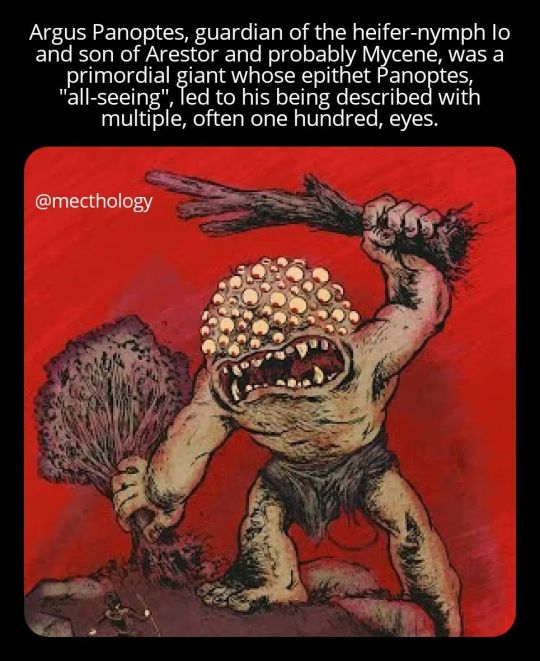
Argus Panoptes from Greek mythology.
Argus was Hera's servant. His great service to the Olympian pantheon was to slay the chthonic serpent-legged monster Echidna as she slept in her cave. Hera's defining task for Argus was to guard the white heifer Io from Zeus, who was attracted to her, keeping her chained to the sacred olive tree at the Argive Heraion. She required someone who had at least a hundred eyes spread out, always watching in all directions, someone who would stay awake despite being asleep. Argos was meant to be the perfect guardian. She charged him to "Tether this cow safely to an olive-tree at Nemea". Hera knew that the heifer was in reality Io, one of the many nymphs Zeus was coupling with to establish a new order. To free Io, Zeus had Argus slain by Hermes. The messenger of the Olympian gods, disguised as a shepherd, first put all of Argus' eyes asleep with spoken charms, then slew him by hitting him with a stone, the first stain of bloodshed among the new generation of gods. After beheading Argus, Hermes acquired the epithet Argeiphontes or “Argus-slayer”.
The sacrifice of Argus liberated Io and allowed her to wander the earth, although tormented by a gadfly sent by Hera, until she reached the Ionian Sea, named after her, from where she swam to Egypt and gave birth to a love child of Zeus, according to some versions of the myth.
According to Ovid, Argus had a hundred eyes. Hera had Argus' hundred eyes preserved forever in a peacock's tail so as to immortalise her faithful watchman.
Follow @mecthology for more mythology and lores. DM for pic credit or removal. https://www.instagram.com/p/CmQ4CqpICCH/?igshid=NGJjMDIxMWI=
#Greek mythology#mythology#mecthology#pagan#primordial#giant#ancient#mitoloji#knowledge#hermes#zeus#hera
9 notes
·
View notes
Text

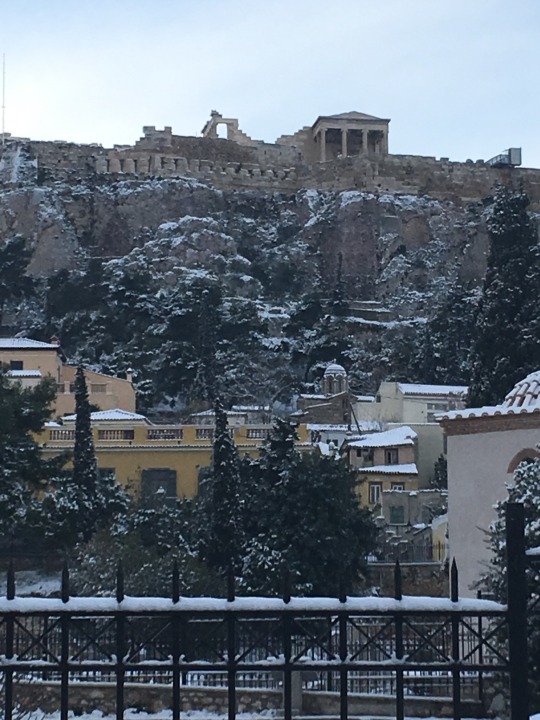
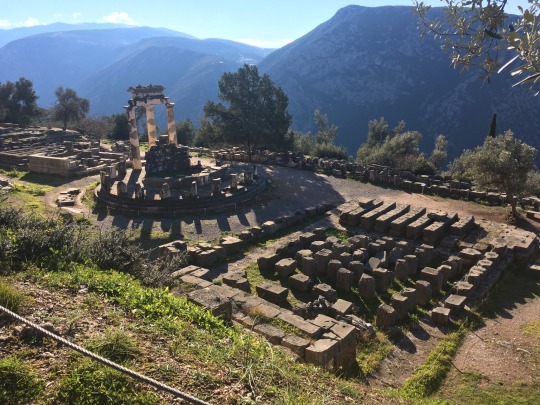
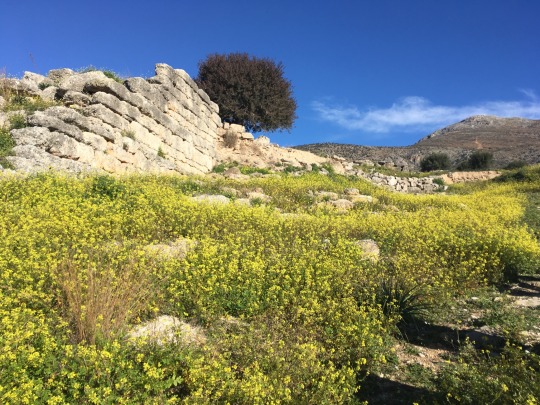

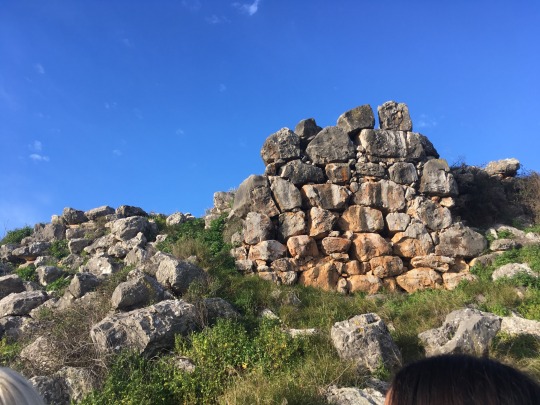
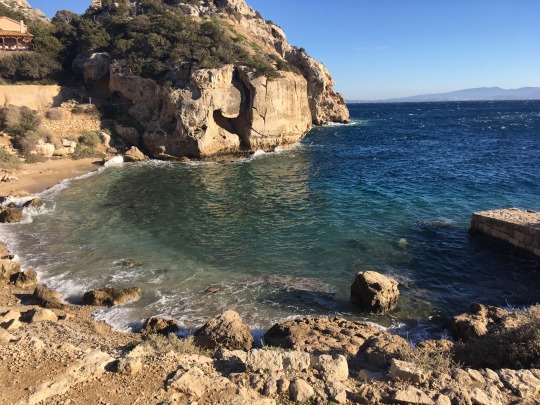
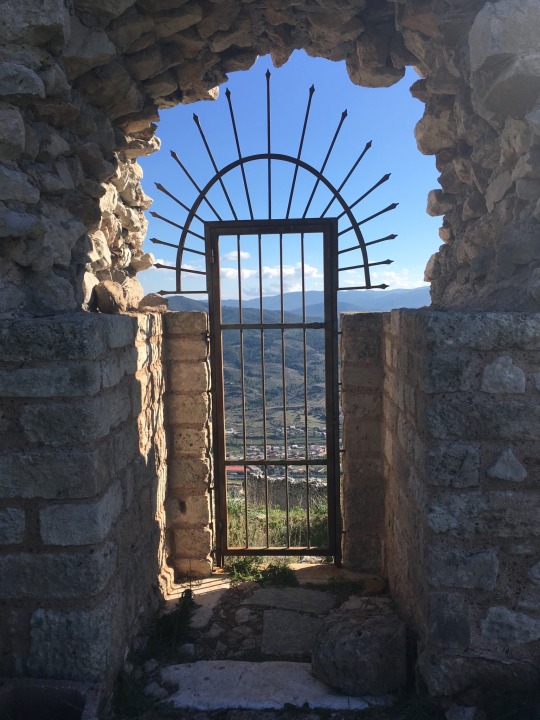


Greece - 2017
#athens#kalamata#argos#argive heraion#corinth#acrocorinth#corinthos#perachora#acropolis#messene#tiryns#mystras#mediterranean#winter#photography#sparta#delphi#greece#cat#cats
8 notes
·
View notes
Note
You said drop some knowledge, so here is why I believe the evil eye originated as a way for Hera to protect a woman from Zeus.
So the Nazar 🧿 is the most widely recognized apotropaic charms against the evil eye. It's the Arab version of the older Greek "eye cups" used to protect against it. The oldest evidence of the evil eye and charms against it are Greek.
I've always thought, but can't prove, that the evil eye ultimately shows us that Hera is a protector goddess.
Io was an Argive princess and priestess of Hera. Argos was home to one of Hera's largest and most important temples. Zeus saw his wife's beautiful priestess and lusted after her. She refused his advances repeatedly, as she was his wife's priestess. Zeus, ultimate God of Prophecy, even over Apollon, caused the local oracles to tell the king, Io's father, to banish her from his home and city.
Here's where it gets iffy -and I swear I'm getting to the evil eye connection. Ovid claims that Zeus turned Io into a beautiful white heifer. These were sacred to Hera. So Hera, knowing what was happening, asked Zeus to give her Io as a gift. He had no choice. Hera placed Io under the watch of Argus, who had 100 eyes all over his body. Only half would blink at a time, so he was always able to watch Io. Zeus, still lusting after Io, sent Hermes to kill Argus and chase Io out of the temple. He defiled her and she eventually had a lineage of heroes.
Hera was devastated by the loss of Argus and placed his eyes upon the tails of her sacred peacocks, in honor of her loyal companion. I believe this is where the evil eye charm comes from. I believe it's a protective symbol of Hera.
Ovid of course paints Hera to be the bad guy. In his version, she sends a gadfly to torment Io once the heifer "escapes." But other sources indicte that Hera bore no ill will towards Io. First, she set her servant to guard Io. That could have been to spite Zeus, or or could have genuinely been to protect Io. Second, she had Argus watch Io inside the grove in the Temple of Hera at Argos (the Argive Heraion) which was one of her oldest and largest temples. Third, priestesses actually observed a mourning ceremony for Io at the Heraion. Would they do that for someone their goddess hated?
The evil eye is often interpreted as malicious envy or covetousness. Zeus coveted Io and ruined her life. Hera tried to counter Zeus' gaze with Argus' watchful eyes. She was trying to protect Io and gave us eye amulets and cups to protect us.
i enjoy your take. my gf loves greek mythology so i feel like she will appreciate this @nephilimfem
14 notes
·
View notes
Text
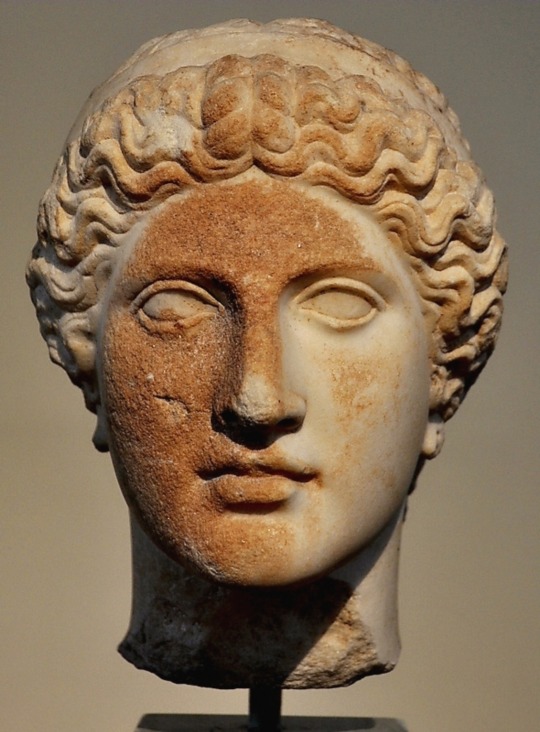
Head of Hera
Marble Head of Hera. Found in the Argive Heraion. It belongs to the cult statue of the goddess or to a statue from the West pediment of the temple of Hera.
Argive work, associated with the school of Polykleitos, circa 420 BC.
(National Archaeological Museum, Athens.)
454 notes
·
View notes
Text
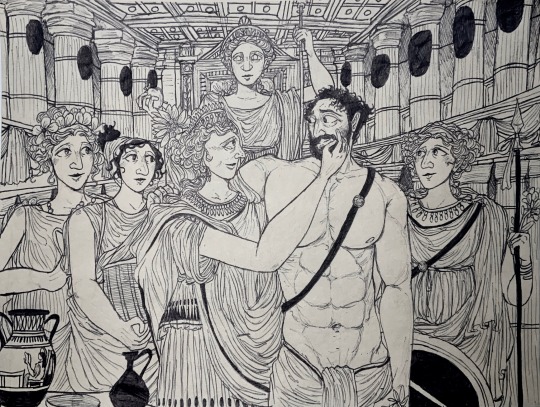
Thinking about drawing the god Ares, again, and along with his mother, Queen Hera and his wife, Aphrodite, as I might delve deeper into the relationship between these two goddesses as well. In the story here, Ares might be visiting one of her most dedicated temples in Argos and Sparta from time to time; since Hera had been worshipped here as a chief local goddess and was given by the Argives by giving her the greatest and wealthiest sanctuary here. (As she had been mentioned that the three cities of Argos, Sparta, and Mycenae are among her favorites in the Illiad.) And through more historical and archeological research about the queen of the gods herself, she seemed to be much more than a “vindictive jealous wife” character in the stories, who always screwing up mortal women and other goddesses out of spite.
According to Pausanias, “the temple that dedicated to her, Heraion on Argos had once a colossal chryselephantine cult statue of the goddess (made out of gold and ivory) wearing the diadem crown that had once made by the Horaes and the Charites. On her hands, she carries a pomegranate and a specter, carved by Polykleitos.” (With one of her favorite birds, the cuckoo located on top of her specter, of course.) Polykleitos had been one of the celebrated sculptors, known for rigorous, mathematically based proportions in his figures. (As he once said that "Perfection comes about little by little through many numbers") It is also said that the statue of Hera was also once in comparison with the statue of Zeus in Olympia, also, once had been called “Seven Wonders of The Ancient World.”
Back to Heraion of Argos, its wall also contains the images of 'the birth of Zeus', a gigantomachy, and the sack of Troy with Hera supporting the Greeks. And from the previous posts of @a-gnosis regarded about Hera, the queen herself seemed to be “one of the earliest goddesses and forces of divinity to be worshipped by Ancient Greeks”, as “one the first Archaic Greek temple that dedicated to the goddess was located on the island of Samos, dated back to the Geometric period.”
Edit: I think I may reference going to be referred to her a lot in my later drawings, since not only that she had a ton of archeological and historical readings about the Ancient Greek civilization, she also based her comics of the Hades and Persephone story on the original sources, too.
#ancient greek#ares and aphrodite#mars and venus#ares#aphrodite#venus#mars#queen hera#juno#little hebe and her sister eileithyia#heraion of argos#hellenistic architecture#my art#hellenic polytheism#greek mythology
12 notes
·
View notes
Text
“Despite Homer’s Panhellenizing tendencies, he recognizes Hera’s regional character as goddess of the Argive peninsula, giving her the epithet Hera Argeia (e.g. Il. 4.8). In historical times she became the city-goddess of Argos itself, and her Argive sanctuary was the most venerable and famed center of her worship. Her festival there, known as the Heraia or Hekatombaia (Sacrifice of one hundred Oxen), was held in the first month of the year. A grand procession escorted the priestess, who rode in an ox-drawn wagon from the city to the sanctuary several miles distant. The youth recognized as most virtuous carried a sacred shield in the procession, marking his and his age-mates’ transition to adulthood and warrior status. After the procession, there were athletic competitions for which the prize was, again, a bronze shield. Hera’s cult at Argos shows a preoccupation with two aspects of the Argolid’s prosperity: the herds of cattle on which its wealth was based, and its military might. Terracotta figurines from the Heraion indicate that Hera was also viewed as a kourotrophic deity, one who nourished and protected the young. Often she is shown holding a child in her lap. Sometimes she holds not a child but a horse, an emblem of aristocratic privilege. Hera’s cult seems to have been closely bound up with the efforts of the early Archaic Argives to define their relationship with the heroic past.
The Argive Heraion was constructed over the remains of a Mycenaean settlement, but there is no clear evidence of continuity of cult from the Bronze Age to the ninth century, when activity at the Heraion becomes archaeologically visible. Around 700, a terrace was built using huge “Cyclopean” blocks in imitation of the Bronze Age architectural style, and shortly thereafter a temple of stone and wood with a colonnade was added. This Archaic structure was not superseded by a newer temple until the fifth century, when the sanctuary was transformed from a rallying center for the towns in the region to a symbol of the power of Argos, by then the dominant city. . . . It possessed sculptures depicting not myths of Hera herself, but subjects of interest to the Argives: the birth of Zeus, the battle of the gods and giants, the Trojan war, and the saga of Orestes. In Pausanias’ time, one entered the temple after walking through a series of statues of the former priestesses (styled kleidouchoi or Keyholders), whose tenures provided a chronological framework for the city’s history. The list of priestesses was already ancient in the fifth century, when Hellanicus (FGrH4 F 74–82) used it as the basis for an account of the Greeks from the Trojan war to his own day.
The cult image of the Classical period was a famous one by Polykleitos, fashioned of gold and ivory over a wood core. The seated goddess held a scepter and a pomegranate, symbols of temporal power and fertility. A more ancient wooden image must have existed, but presumably was destroyed when the Archaic temple burned in 423/2. When Pausanias (2.17.3) visited the temple, he saw a venerable image of pearwood taken from nearby Tiryns, another ancient Heraian cult center, which the Argives had installed on a pillar beside Polykleitos’ statue. The pillar itself may have held special significance, for a fragment of the Argive epic Phoronis (fr. 3 Davies, EGF) describes Hera’s priestess adorning “the high column of the Olympian queen, Hera Argeia” with fillets and tassels. Another item of interest in the temple was the “couch of Hera,” a symbol of Hera’s status as the bride of Zeus.
The Asterion river near the Heraion was regarded as the father of Hera’s three nurses, the nymphs Akraia, Prosymna and Euboia, who were named after features of the sanctuary’s topography. Local tradition, therefore, held that Argos was Hera’s birthplace. Women conducted secret rituals at the Heraion, involving purifications, sacrifices, and the offering of garlands twined from a local herb also called asterion. The women wove a robe for Hera, as they did at Olympia, first taking a ritual bath in the waters of the spring or well called Amymone. The hundreds of miniature water vessels (hudriai) from the excavations further attest the importance of water in these activities. Perhaps the ritual involved a bath for Hera’s image; a legend describing how Hera took an annual bath to restore her virginity was attached to the spring Kanathos in nearby Nauplia. The “water of freedom” of the stream Eleutherion, near the Heraion, was used for the women’s secret rites, and was also drunk by slaves and prisoners about to be emancipated.”
- Ancient Greek Cults: A Guide by Jennifer Larson
15 notes
·
View notes
Text
“O'Brien, who deals extensively with Hera's role in the Argolid, 16 states that, ironically, while the Argives were building the Heraion, Hera's status was actually in decline due to the penetration of the Homeric epic tradition, which represented Hera as part of the "Panhellenic family" and as a less than sovereign "wife and sister". 17 This conclusion partially converges with my conclusions, but, to my mind, the critical question that emerges from this fact is why should the Argives choose to build such a magnificent temple to a weak goddess whose status was in decline?
In answer, my working hypothesis is formulated in terms of the tension between aristocratic particularism and Panhellenic tendencies. The aristocrats in the Argive plain shaped Hera's cult and temple as a response to the postulated Panhellenic wave that swept through many areas of Greece. For them, Hera was not only a mediator with the past but a symbol of their exclusive heroic past, and thereby of their identity. Devotion to Hera enabled them to mark their uniqueness in the face of the changes occurring in the Greek world. Based on this interpretation, there is nothing 'ironic' in the building of the Heraion: Rather, it was part of an effort to construct and preserve an aristocratic identity and ethos that would assist regional aristocrats in maintaining the distinction between themselves and the rest of their local society. Hera was given an important role in this campaign. Her cult was the local aristocratic alternative, the answer to an emerging Panhellenic tradition which centered around the idea of the powerful god, Zeus, who married his wife and sister, Hera.”
- Marrying Hera: Incomplete Integration in the Making of the Pantheon
Neta Aloni-Ronen
4 notes
·
View notes
Text
Hera and the River Gods of Argos

"I go now to the ends of the generous earth on a visit to Okeanos, whence the gods have risen, and Tethys our mother who brought me up kindly in their own house, and cared for me and took me from Rheia, at that time when Zeus of the wide brows drove Kronos underneath the earth and the barren water." Iliad 14.200
As early as the Iliad, Homer claims Hera was raised by Okeanos and Tethys, the river encircling the world and his wife the goddess of all freshwater. In the Iliad, Hera, as the goddess of marriage, wishes to travel to see them to fix their broken marriage so they may forever call her dearest and worthy of reverence. While there are several stories of where Hera was raised after being disgorged by her father, this particular one is perhaps a nod to her oldest cult site and patron city, Argos. Argos is one of the cities that claims to be the birthplace of Hera, and has their own myth of her upbringing upon their riverbanks. Here she was raised by the Asterionides, not the titans.
"The sanctuary [of Hera] itself is on a lower part of Euboia. Euboia is the name they give to the hill here, saying that Asterion the river had three daughters, Euboia, Prosymna, and Akraia, and that they were nurses of Hera. The hill opposite the Heraion they name after Akraia, the environs of the sanctuary they name after Euboia, and the land beneath the Heraion after Prosymna. This Asterion flows above the Heraion, and falling into a cleft disappears. On its banks grows a plant, which also is called asterion. They offer the plant itself to Hera, and from its leaves weave her garlands." Pausanias 2.17.1
Hera’s special bond with the potamoi is linked to her patronage of Argos itself. Pausanias relates two local tellings of the story in which Hera won the Argolid in a contest with Poseidon, as judged by the river gods, or, the King Inakhos, eponymous of the local river. This story also cements the line of kings in Argos, as either the mortal Inakhos or the divine river of the same name was the ancestor of Phoroneus, the first man and supposed founder of the city.
“The land [of Argos] was without water [when Danaus and his daughters arrived there], thanks to Poseidon, who, in anger at Inakhos for testifying that the region belonged to Hera, had dried up even the springs.” Pseudo-Apollodorus, Bibliotheca 2. 13
"The oldest tradition in the region now called Argolis is that when Inakhos was king he named the river after himself and sacrificed to Hera. There is also another legend which says that Inakhos . . . was not a man but the river. This river, with the rivers Kephisos and Asterion, judged concerning the land between Poseidon and Hera. They decided that the land belonged to Hera, and so Poseidon made their waters disappear. For this reason neither Inakhos nor either of the other rivers I have mentioned provides any water except after rain." Pausanias 2.15.4
"They say that Poseidon inundated the greater part of the country [Argos] because Inakhos and his assessors decided that the land belonged to Hera and not to him. Now it was Hera who induced Poseidon to send the sea back, but the Argives made a sanctuary to Poseidon Prosklystios at the spot where the tide ebbed." Pausanias 2.22.4
While the bathing of a goddess’ image is a widespread practice, one particular instance of this is the yearly procession of Hera’s image south from Argos to the Kanathos spring in Nauplia. There, Hera is bathed and regains her virginity, presumably before her ritual marriage to Zeus. Pausanias mentions a potential mystery cult of Hera, and at the Heraion in the Argolid there is a spring that flows beside the temple where Hera’s priestesses also partake in their own ritual.
"In Nauplia is a spring called Kanathos. Here, say the Argives, Hera bathes every year and recovers her maidenhood. This is one of the sayings told as a holy secret at the Mysteries which they celebrate in honor of Hera." Pausanias 2.38.2
As the patron of Argos and undoubtedly concerned with the success and fertility of her beloved city, it is no wonder Hera has such recurring close ties with the rivers of her sacred land.
18 notes
·
View notes
Note
do you have any recommendations for researching hera as she was worshiped traditionally, rather than info based on the myths? specific books would be wonderful, but even phrases/sites to search would be great. most everything i'm finding is either the myths (which i haven't found helpful) or behind a paywall/university link (like jstor etc) much appreciated either way, i love your blog & reading about your views!
Hi!
First, thank you for the kind words :)
I’ve looked a little into what I had at hand and what I could find about Hera in my personal cluster of pdf. You’ll find useful chapters about her cult in Ancient Greek Cults, a guide by Jennifer Larson and in Girls and Women in Classical Greek religion by Matthew Dillon.
Now, when it comes to researching, the first advice I’d give is to also look for cultic information about Zeus. Simply because they were very often worshipped together, as the sacred marriage “hieros gamos”. This term alone will link you back to her cult in Samos and her massive temple there, the Heraion of Samos. As this tells you, looking for her temples and local cults will help. She was very present in the Pelopponese, in Samos, in Thespiae, on the island of Kos and in Argos (check the terms Argive Hera and Heraion of Argos).
Another possibility for you is to give a look at the topic of women in the ancient world. Hera is the matron and ideal woman/wife in ancient greek thought and thus was very relatable for women. She covers all ages of life, from maidenhood to widowhood. Important epiteths on that matter will be Hera Pais (maiden/virgin), Teleia (married to Zeus) and Chera (widow).
I hope this gives you some key information and useful advice. However, please please please DM me. I have more stuff that could help which I could just share with you.
62 notes
·
View notes
Text
Day 12 of 30 Days of Hera
Places associated with this deity and their worship
There are few places that are associated with Hera in mythology, there are more places associated with Zeus and their mother Rhea however and whether she has a claim on those places too (as his wife) and maybe a claim on the other god’s places (due to being Queen) I am unsure

Mount Ida in Turkey: Trojan War - The mountain is the scene of several mythic events in the works of Homer. At its summit, the Olympian gods gathered to watch the progress of the epic fight. But the mountain was the sacred place of the Goddess, and Hera's powers were so magnified on Mount Ida, that she was able to distract Zeus with her seductions, just long enough to permit Poseidon to intercede on behalf of the Argives to drive Hektor and the Trojans back from the ships.
Mount Olympus: In Ancient Greek religion and mythology, "Olympus" was the name of the home of the Twelve Olympian gods of the ancient Greek world.[11] This was conceived of as a lofty mountaintop, and in all regions settled by Greek tribes, the highest local elevation tended to be so named; among the numerous peaks called Olumpos in antiquity are mountains in Mysia, Laconia, Lycia, Cyprus, Attica, Euboea, Ionia and Lesbos, and others. Thessalian Olympus is the highest peak in any territory with Greek settlement and came to be seen as the "Pan-Hellenic" representative of the mythological seat of the gods, by at least the 5th century BC, as Herodotus (1.56) identifies Olympus as the peak in Thessaly.In Pieria, at Olympus's northern foot, the mythological tradition had placed the nine Muses, patrons of the Fine Arts, daughters of Zeus and the Titanide Mnemosyne.[12]
Kanathos: In ancient Greek religion, Kanathos (Greek: Κάναθος) in the Argolid was the spring at Nauplia,[1] where Hera annually renewed her virginity. There, Pausanias noted,[2] was "a spring called Kanathos where, so say the Argives, Hera bathes every year and, by so doing, becomes a maiden; it is this story which is of the secrets connected with the rites which they perform to Hera." The unspoken nature of the ritual forbade its being embodied openly or directly in Greek mythology. S. Casson suggested that it was the obscure subject of the so-called "Ludovisi Throne", generally considered to represent the parallel, and far better-known, renewal of Aphrodite,[3] bathing in the sea at Paphos.
Olympia, Greece: The Altis consists of a somewhat disordered arrangement of buildings, the most important of which are the Temple of Hera (or Heraion/Heraeum), the Temple of Zeus, the Pelopion, and the area of the great altar of Zeus, where the largest sacrifices were made. There was still a good deal of open or wooded areas inside the sanctuary
Garden of the Golden Apples: As a wedding present Gaia created for her the famed garden of the golden apples, which the Hesperides and the Drakon Ladon were set to guard.
She also had cults and epithets from the following places:
Attica, Southern Greece
Corinth, Southern Greece
Sicyon, Southern Greece
Argolis, Southern Greece
Laconia, Southern Greece
Elis, Southern Greece
Arcadia, Southern Greece
Boeotia, Central Greece
Opuntian Locris, Central Greece
Samos, Greek Aegean
Lydia, Anatolia
Egypt, North Africa
Bruttium, Southern Italy
Picenum, Southern Italy
Venetia, Northern Italy
Rome & Latium, Central Italy
Iberia, Southern Spain
#30 days of deity devotion#30 days of devotion#30 days of hera#dodekatheism#hellenic polytheism#hellenismos#hellenic pagan#for the love of apollo#for the love of the dodekatheon#ares is great#Hail King Zeus and Queen Hera#hermes is my god#Hades is great too#Hestia is a sweetheart
6 notes
·
View notes
